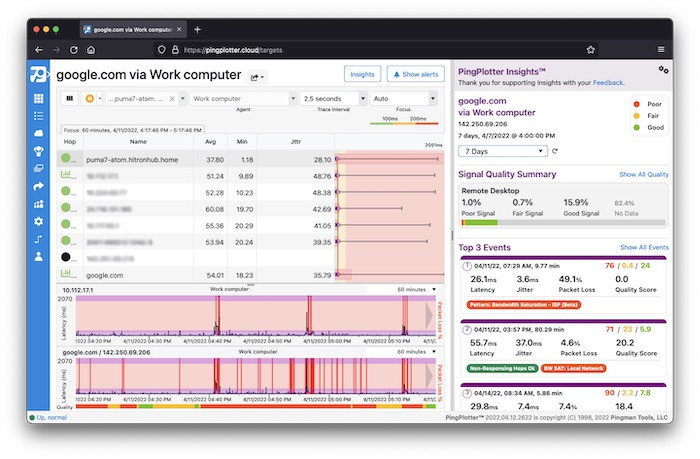Product Review: PingPlotter Addresses Remote Agent Connection Woes, Yielding A Higher-Quality CX
Add bookmark
Leaving no doubt about the value of remote work, a whopping 91% of contact center leaders say they have no plans to ever return to a wholly on-site model.
Accepting remote work as a viable option is not, however, the same as calling it a perfect one. Contact center leaders have spent the past two years uncovering numerous challenges that they must correct if work-from-home is to transition from crisis response to elective strategy.
No challenge ranks higher than interaction quality. Noting vast discrepancies in at-home work environments, a staggering two-thirds of leaders cited poor connections as a major challenge in CCW Digital survey on contact center strategy.
Not all quality issues have a solution. Some agents will work in cramped city apartments with an abundance of street noise, pet disruption, and roommate interference. Some agents will join team Zoom meetings from poorly lit home offices with tacky background furniture.
Connection issues, on the other hand, most certainly do have a solution. Modern tools empower companies and their remote agents to diagnose and troubleshoot connection issues in an intuitive manner. Agents can quickly return to supporting – and building relationships with – their ever-demanding customers, while the IT department can focus on bigger picture strategy.
CCW Digital crowns PingPlotter as a standout solution in this Network Monitoring & Management Solutions market.
The stakes of customer conversation quality have never been higher
At no point in modern history would any customer – or customer contact leader – have declared interaction quality irrelevant. The ability to foster quick, clear communication has always been a building block of customer centricity.
Thanks to recent marketplace trends, the stakes of quality have nonetheless reached an all-time high.
As they become increasingly comfortable using self-service and lower-touch digital options, customers are becoming less reliant on agent support for simple, transactional issues. When they do speak to agents, particularly phone agents, it is for assistance with complex issues that require more detailed and empathetic conversations. If either party has trouble hearing, a likely outcome when the agent is operating on a low-quality connection, the interaction is doomed to be inefficient and ineffective.
“Voice technology requires a minimum amount of bandwidth and consistent latency. An internet connection missing these requirements results in poor conversation quality. Echos, dropped calls, garbled speech are examples of how poor connection quality manifests in these conversations … Conversational interruptions reduce productivity for any contact center rep, and are especially costly and painful for contact centers handling crisis line types of conversations. For example, one dropped call for the National Domestic Violence Hotline could have dire consequences,” says Taylor Edginton of PingPlotter.
Making matters worse, an agent suffering from connection issues may also struggle to access essential enterprise systems. Agents who cannot instantly access key customer data or knowledge have little chance of connecting with customers who are asking harder questions – and demanding more personalized answers.
The reality of agent autonomy
In a traditional office environment, employees are accessing the same systems, from the same devices, using the same network infrastructure that is being closely monitored by the same, centralized IT team. Unique connection issues are unlikely, and if they do occur, the agent can quickly ask a desk neighbor or on-site IT representative for help.
In the remote world, employees are relying on their own, highly variable connections and therefore far more likely to encounter unique problems. Lacking close proximity to peers, they have to rely on virtual means – which could be compromised by the same connection issue they are trying to resolve in the first place – for seeking help. Making matters worse, the IT team members most capable of helping have little-to-no inherent visibility into the connection problems plaguing an individual remote agent.
“Most contact centers were designed under the assumption of everyone working at the same location, or maybe a handful of offices, on a centralized corporate network. The systems and solutions put in place are often unable to provide visibility into a remote worker’s home network,” adds Edginton. “If issues are bad enough an employee may not be able to use their phone or internet-dependent tools (e.g. ticket system) at all. When contact centers do not possess the tools required to identify the cause of internet problems, IT is forced into a trial-and-error troubleshooting process that can take days or even weeks.”
The long-term success of a remote work model requires companies to mitigate this challenge, ensuring that individual agent connection issues do not render them unable to support customers in today’s highly competitive landscape.
PingPlotter: A powerful solution
To overcome the remote connection challenge, companies require a solution that can accomplish several goals:
- Provide a simple mechanism for agents or IT leaders to easily test and diagnose connection issues.
- Provide data that agents and IT team members can easily access and interpret.
- Offer real-time insights to replicate the visibility and monitoring IT teams would have in a traditional, on-site environment.
- Empower stakeholders to take the necessary action, ensuring that solvable connection issues do not linger – and inherent issues do not trickle down to the customer.
It is against this criteria that PingPlotter shines as a remarkable, employee-centric solution. The solution allows employees and teams to quickly yet thoroughly test remote connections against a variety of factors, emphasizing the impact on the end-user experience and opportunities for correcting or mitigating problems.
Stunningly Simple: Recognizing that customer support employees are not necessarily IT experts, the PingPlotter tool emphasizes convenience and ease of use. PingPlotter testing agents can be managed from a single interface and deployed quickly and intuitively on employee networks. LiveShare capabilities allow IT team members to productively discuss the findings with individual employees, fueling collaborative solutions rather than unilateral accusations.

Accurate and Authoritative: The convenience does not come at the expense of comprehensiveness. PingPlotter provides a look at crucial metrics like latency, packet loss, jitter, and mean opinion score while providing 1-second sample rates that ensure more accurate and actionable diagnostics.
Insightful Analysis: PingPlotter Insights emphasizes actionability and readability, providing real-world summaries and explanations for the findings. The intuitive dashboard, for example, will reveal when a particular agent would not have been able to engage in a particular call or complete a particular task. Just as importantly, it pinpoints the network events that contributed to the quality bottleneck. Visual diagnostics capabilities help bring the conclusions to life, providing a democratized breakdown of where the connection is going wrong.
Objective, Device-level Drilldown: Aware that network troubleshooting conversations have historically been ambiguous at best and argumentative at worst, PingPlotter removes guesswork from the equation. By pinpointing problematic network events, and tracing them to specific devices where possible, the platform ensures productive conversations between IT leaders and frontline agents. More importantly, it ensures real resolutions.

Proactive Guidance and Automation: Not simply a way to “prove” the source of past problems, PingPlotter monitors for potential problems to notify support professionals and trigger automated, customizable results. Automated troubleshooting also applies in reactive cases, ultimately yielding a more efficient and consistent IT process.
PingPlotter: Appreciating the full scope of benefits
PingPlotter is everything that historical network monitoring and management solutions are not: simple, quick, democratized, solution-driven, and geared to the remote world. To simply appreciate the usability of the product, however, is to understate the immense value it delivers to contact center functions.
Improves conversations: From identifying inhibitors to VoIP interactions to helping agents access enterprise systems more quickly, PingPlotter ensures that supporting remote work does not come at the expense of call quality. Agents will hear what customers need, and customers will hear what agents intend to deliver.
Improves employee experience: Modern contact center leaders know that agent effort is a driving force behind employee satisfaction and retention. By quickly (if not proactively) resolving most connection problems, PingPlotter empowers employees to focus on doing what they are meant to be doing: connecting with customers. They will spend less time engaging in troublesome conversations, and less time explaining (and arguing about) problems with IT.
Improves IT efficacy and focus: With visual, actionable insight into employee connection issues, the IT team can provide more timely, valuable solutions. By simplifying the monitoring and troubleshooting process, PingPlotter also enables IT leaders to focus on the bigger picture, more strategic challenges that are more fulfilling to them and more valuable to the greater business.
Helps contextualize customer data: By correlating contact center metrics with agent-level network diagnostics, contact centers may be able to identify root causes – and thus potential solutions – for customer sentiment or satisfaction challenges.
Helps improve workflow allocation and recruiting: PingPlotter absolutely will help customer contact teams diagnose and resolve connection issues, but it cannot solve all problems. Some remote agents will be attempting to engage on poor connections, with poor devices. Upon uncovering these inherent limitations, customer contact leadership can make intelligent decisions about allocating resources. It may, for instance, decide that an agent whose connection cannot support high-quality VoIP calls should focus entirely on messaging and chat support.
PingPlotter’s insights can also help at the recruiting level, ensuring that phone-heavy contact center teams do not extend offers to those with unreliable networks.
“Hiring someone with a sub-par internet connection results in unnecessary productivity loss and cost,” explains Edginton. “New employees with poor internet connections are unable to meet performance goals. If their internet connection cannot be fixed, the employee must be replaced. Replacing another contact center rep in an industry with already-high turnover incurs more cost that could have been avoided. HR departments have an opportunity to pre-qualify candidate internet connections before an offer is made to avoid the costs.”
Success spotlight: PingPlotter helps Ruby reduce resolution times, Improve onboarding
As a virtual receptionist company with 750 remote employees who field 40,000 calls daily, Ruby has seen its fair share of connection challenges. Thanks to PingPlotter, it was able to reap the rewards of resolution.Because many of the issues are happening at the employee-ISP level, Ruby cannot outright prevent all problems from occurring. The combination of 1-second interval testing and LiveShare, however, allows Ruby to track – and explain – the problems with high degrees of accuracy and clarity. This allows the organization and its employees to address the issue more quickly, minimizing the frustration and delay that comes from lengthy IT support tickets.
Not simply useful for those on the job, PingPlotter helps Ruby elevate its onboarding process. By monitoring the connections of its “nubys,” Ruby can identify and mitigate issues before the employee officially begins taking live calls.
For more information, and to get started elevating quality and streamlining the IT troubleshooting process, visit PingPlotter on the web.


























